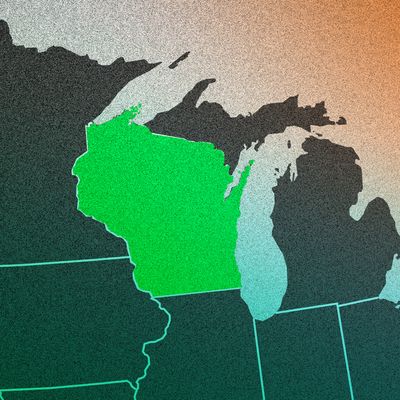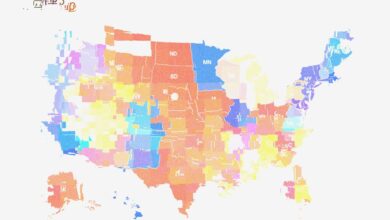

Photo-Illustration: Intelligencer; Photo: Wikimedia Commons
For more than a decade, Wisconsin has been at the white-hot center of American politics. After a long stretch of Republican dominance there — capped off by a shock Trump win in 2016 — Democrats have mounted a considerable comeback in recent years. They ousted Scott Walker in 2018, tilted the state to Joe Biden — barely — in 2020, and gained a majority on the state supreme court, breaking Republicans’ suffocating statewide gerrymander. Polls show Kamala Harris with a small but persistent edge over Donald Trump, but for two straight presidential cycles, polls have dramatically overestimated Democratic strength in Wisconsin.
Nobody knows more about Wisconsin voting trends — or is more aware of those polling issues — than Charles Franklin. A professor of law and public policy at Marquette University, he has run the widely respected Marquette Law School survey since 2012. (FiveThirtyEight rates it as the third best in the country.) I spoke with him about where he thinks Harris vs. Trump stands in the Badger State, how political demographics in Wisconsin have flipped over the years, and why he isn’t sleeping that well right now.
The New York Times recently ran a piece with the headline, ‘Harris has a polling edge in Wisconsin, but Democrats don’t trust it.’ And you were quoted in there saying, “My numbers are my numbers, but I think in terms of putting it into context, four points would be a surprisingly strong finish for Harris.” That was referring to Marquette’s most recent poll, which had Harris up 52 and 48 over Trump. Do you have a different sense of the race than the numbers that you actually put out?
It’s the paradox of polling that the polling represents the best data that I’m able to produce. We do the methodology as best we can, but there’s always the subjective side about whether this is a four-point race at this stage. A reason for reticence is that four of the last six elections were decided here by less than one percentage-point margins, so a four point win for either side would be unusually large for recent years. Governor Evers was reelected in 2022 with a 3.4 percent margin, and he’s the most popular politician in the state.
The other reason, of course, is polling errors. We were off in 2016 by over six points, and we were off by about four points in 2020. At least in 2020 we got the winner right, which was an improvement. So those are just reasonable cautions to anyone reading polls — to look at the history of races in the state and look at previous polling errors and come to your own judgment.
People just always want to know who’s going to win. And there’s no good answer for that.
Yeah, and my standard answer this year is “Give me a quarter and I’ll flip it for you,” which is not entirely tongue-in-cheek. I think we are so close in so many battleground states that forecasts from now to November are perilous.
In late 2020, as you said, you were off by four points near the end of the Biden-Trump race. That was still quite a bit better than some — ABC News and the Washington Post memorably had Biden up 17 in late October.
Yes. That gets repeated every time, with good reason.
I think I was skeptical of that one at the time.
Well, Gary Langer, who conducted it, was skeptical.
Good for him.
Seriously, this isn’t really your focus, but within the polling community, it is a mark of some integrity that you publish your results as they stand and not hide the ones you don’t believe in. So in that sense, kudos to Gary and to ABC for putting that out. But we saw a range of polling in 2020 up in the nine, 11, 17 range.
Yeah, the Times had him up 11, so they were far from alone.
One of the paradoxes for us is our long-term average error across all of the races we’ve done is 2.2 percentage points. So we were off by four in 2020, which was double our average error, but we still look pretty good compared to all the other pollsters. It’s sort of cold comfort to be the least inaccurate poll, or one of the least inaccurate, but it does show that a lot of pollsters have come through Wisconsin and left with much bigger overestimates of the vote than we have.
The common story told about 2016 is that Trump was reaching all these white working-class people who may have been infrequent voters, and who were undersampled in polls. But do you have as good a sense of what went amiss in 2020 as you do in 2016? And how have you tried to repair whatever problems you’ve found?
My view of ‘16 and ‘20 is more or less the way you stated it, that Trump has done a remarkable job of activating people who hadn’t participated before, who are disgruntled with the political system. And the profile of those folks are exactly the profile of folks that don’t want to do polls. They distrust politics, they distrust the media, and they distrust pollsters. The net effect is not huge, but it’s three or four or five percent that were understating Trump’s support in ‘16 and in ‘20. And the challenge for pollsters is: Is there any way to reach those folks who are supporting Trump and probably will go to vote this time when they are so skeptical of mainstream media and pollsters and so on?
So we’re doing what we can, and we’ll know in November whether we’ve succeeded in that or not. What we’ve changed is that in the past, we stratified the state into five regions: Milwaukee, the rest of the Milwaukee media market, the Madison market, the Green Bay market, and the north and western parts of the state. But now we divide the state into 90 different regions, which we stratify from the most Republican and the Trumpiest to the most Democratic and least Trumpy. We sample people in all of those 90 strata trying our best to make sure that we’re reaching people in the very Trumpy areas of the state, who maybe we were missing on the telephone before, when we would just say “Call into the Green Bay media market.” We didn’t directly control to make sure we were getting the right percentage of respondents from the more Trumpy parts of the market as opposed to the more Democratic-leaning ones.
So by drilling it down into the smaller sections, you’re able to get more specific in the people you’re reaching?
Yes. We still can’t make people talk to us. But we now send an email and a text message with links to where they can complete the poll online, on their phone or whatever. Then we follow up with reminders, and if they haven’t responded in a couple of days, we phone them. We end up with about 20 percent of the interviews still done by phone, and about 80 percent completed online, and we’re monitoring how well we’re doing in reaching those Trumpier areas of the state. And we adjust for non-response from those areas. Still, you’d rather that a hundred percent of the people we contact would do the interview, but that never happens.
The response rate is so low, it’s a wonder that polls are as accurate as they are.
It’s true. In the past, I would’ve just said Democrats and Republicans alike loathe scam marketing calls or telemarketing calls. These days, there’s a little bit more of a political veneer to that. Again, the Trump supporters are more negative toward the media and pollsters than I think average Republicans in the past were. And so there is a bit of a partisan edge to non-response now in a way that I don’t think there was in 2010 or 2012.
There’s been this pattern throughout the Midwest where pollsters have been pretty accurate in elections when Donald Trump isn’t on the ballot, and less so when he is. Do you think that’s because there’s a set of people who only vote when he’s running? That’s one of the hypotheses.
There’s that element, but we don’t want to overstate it — not all Trump voters fall into this category. But if three to five percent of Trump voters are folks that are motivated predominantly because of him, then they’re much more likely to drop out of the electorate in the midterms and even in the primaries — I’m talking about statewide primaries, not presidential primary. In 2018, we had the governor’s race within one point and the senate race by a tenth of a point. So that was sort of proof that it wasn’t that polling itself was broken, but it was something about the difference between the ‘16 context and the 2018 context. Then in ‘20, we improved over where we’d been in 2016, but we were still off by more than average. And then in 2022, our error was right at our long-term average, back to normal if you will. So yeah, that’s the reason that I am not sleeping as well as I should.
How nervous are you right now?
I’m nervous enough, but I’ve done everything I can. We’ve adjusted our methodology and we’re tracking how we’re doing, but I’m not going to change anything between now and Election Day, and the proof will be whether we’re close or not. It’s a fool’s errand to try to change what you’re doing in the polling if you feel queasy about the result. I’d much rather go out and say right now “Harris is up by four” rather than squirrel away in my office, and go, “Oh, I should change this, that and the other thing and get it down to a two-point lead.” That would be grossly unethical and irresponsible.
Earlier in the year, we had Trump leading by one or two points in several of our spring polls, and that was against Biden. Biden was tied with Trump just before that debate. And then in our July poll, we had Trump 50 to Harris 49 with registered voters and Harris 50 to Trump 49 with likely voters. The point I’m trying to make is that our polling throughout the year may be biased, but it’s not a bias that has prevented us from seeing Trump ahead in several of our polls. Now, maybe he was ahead by more, but we’re not in the situation of having shown the Democrat up by four to six points in every poll all year.
Which was true the last couple cycles, I believe.
Yeah, in ‘16 and in ‘20, Clinton and Biden led pole to pole, basically.
Are there particular demographics you consider especially important? The thing with these close races is that everything is key, right?
That’s exactly right. You and me and 21,000 of our best friends can tip the race here. But I think the broad picture is Madison and surrounding Dane County is just an amazing turnout machine. It’s the fastest- growing county in the state, as it has been for 20 years. The margins here have become phenomenal. Madison’s always been a Democratic city, but 15 years ago it was producing margins by 20 and 30 percent for the Democrat. Now they’re getting awfully close to 60-point margins.
Approaching Brooklyn margins.
Exactly. Dane County as a whole has just about as many registered voters as the city of Milwaukee does. But because Dane has such exceptionally high turnout and these increasingly huge margins, it is now influencing the statewide vote at least as much as Milwaukee is. They’re both critical for Democrats to do well in, and Democratic fears about lower black turnout or slippage with Hispanic voters in Milwaukee are well-founded, but there’s more going on in the state than just the Milwaukee vote.
Then you’ve got those WOW county suburbs.
Waukesha, Ozaukee, and Washington counties, outside Milwaukee.
The slippage for Republicans there has been clear since 2010, and it’s true across all offices. Scott Walker, whose political base was in the WOW counties, slipped in each of his elections there. Ron Johnson has managed to win each of his elections, but by decreasing margins in the WOW counties. In 2022 for the first time, the Republican vote for governor in Waukesha County slipped under 60 percent, and that used to be in the high sixties or seventies. Ozaukee County has come to be nearly a 50/50 county — they voted 50/50 in the August primary on two big referenda that were on the ballot. I would still expect them to end up being 54 or 55 percent Republican, but that’s down a lot. It’s only Washington County that’s held on and has slipped a good deal less than the others. Those three counties together voted 36,000 fewer net Republican votes in 2020 than they had in 2012. 36,000 net in a 21,000 margin state is a lot to lose.
And that’s reflective, I assume, of the general broader trend of white college-educated people drifting toward the Democratic Party — even in place like the Milwaukee suburbs, which has been famous for being a bastion of GOP sentiment right outside a very segregated city.
Yeah, it was one of the sharpest divides in the country when you crossed the Milwaukee County border. You just either fell off a cliff or rose up a cliff depending on which way you want to look at it . There’s still big differences, but they’re not what they were. There’s a little greater racial and ethnic diversity in the WOW counties now than there used to be. The Democratic Party is really organized well in Waukesha and Ozaukee. So there has been some just simple old-fashioned hard work at organizing Democratic voters in those areas.
Last year I interviewed Ben Wikler, the state’s Democratic Party Chair. he party infrastructure in Wisconsin is kind of famous at this point. It has helped lead to victories in the 2020 presidential election, the two governors races, and a pivotal state supreme court race. On the other side, it seems like the Republican infrastructure is a bit of a black box in Wisconsin and elsewhere. It’s being outsourced, at least in part, to outside groups run by Elon Musk and others, and there’s been some grumbling about that. Based on what you’ve seen and heard, what do you make of the GOP ground game right now?
This has been a real shift in the party’s strengths here. During the time that Scott Walker was governor after 2010, and especially after the recall attempt to kick him out of office in 2012, Walker developed an incredibly strong national fundraising base. And that brought massive amounts of money into the Walker coffers, some of which was redistributed to help Republican legislative races and other races in the state. At that time, the Walker/Republican organization was especially strong and the Democrats were especially weak with changing leadership and difficulty with fundraising and so on.
Since Walker lost in 2018, it’s been the other way around. Republicans have struggled as a party organization to raise money and are woefully short on money compared to the Democrats. As you were saying, Wikler has done an amazing job of growing their fundraising and building organizational strength through the state.
Now, there are some pockets of Republican strength. The legislative fundraising committees are doing bigger money donations than the state party is doing. and I think the Republican Party is relying on the volunteers in the county parties, which are quite active. I’m on everybody’s mailing list, so I see all of the events that they’re listing every weekend, and the Democratic events too for that matter. There’s a lot of activity going on out there, but on the Democratic side, it’s guided by the party. You have tons of local offices that the Dems have created and staffed with professionals, and I think it’s much more of a volunteer effort on the Republican side. As for the Elon Musk PAC and those kinds of things, I have no idea what they’re doing. I don’t mean that pejoratively, I mean, that’s my ignorance. I’m not seeing obvious signs of their activity, but that doesn’t mean they aren’t being very active. It’s just not visible to me.
And Republicans aren’t struggling everywhere in the state, either.
Look at the north and west, basically from Wausau in the north central part over to the Minnesota border, and from La Crosse up. That’s a region of about 26 percent of registered voters. So while it’s thinly populated, cumulatively, it’s a good share of the vote. If we go back 20 years to the 2004 election, Kerry and Bush were very close to each other throughout that region. The counties were just slightly Republican or just slightly Democratic and very competitive. In 2020, that region was overwhelmingly red. The cities within the region — and they’re smaller cities like Eau Claire and La Crosse, and actually Wausau City itself — those places are fairly democratic or even strongly Democratic. But the surrounding countryside is very Republican.
So while those suburbs in the southeast have been moving in a less Republican direction, the northern and western part of the state is getting more and more Republican in every election. Can Trump further boost the turnout in that area, and can he profit by getting his margins throughout the rural parts of the state to be even bigger than they were in 2020? That region of Wisconsin is still less Republican than would be expected, if we look at how folks with those demographics vote nationwide, But that just may mean that there’s still room for them to move further red, and that could offset most, if not all, of the Democratic gains in the southeast.
And that’s where infrastructure might come into play, right?
I fully expect a high Republican turnout in November, as I expect a high Democratic turnout. The question is, if we’re a 20,000 vote margin, how much do the differential efforts and resources at that point matter? And you’ve got to believe it can matter for 20,000 votes statewide, but it’s just awfully hard to measure in any reliable way who really has the upper hand. You mentioned the races that have been good for Democrats, and the strength of the party and success rate is to believe the Democrats might have an edge this year compared to 2020.
But don’t forget Ron Johnson. Because the Johnson campaign started behind, more unfavorable than favorable, and strengthened throughout the campaign and then pulled out a one-point win in 2022. He had also started behind in 2016 and came back to win. So whether that’s the strength of Johnson or his campaign managers…
I have to say, I do not understand that guy’s political survival over the years. It’s mystifying to me.
We elect both Tammy Baldwin and Ron Johnson — not on the same ballot, but it really is a unique and somewhat puzzling combination of those two senators.
Trump was never as overwhelmingly dominant with Republicans in Wisconsin as he was in other places, and I wonder how that fact has contributed to the dynamics there now.
The Democrats are stunningly negative towards Donald Trump in all of our polling this year. It’s not a surprise, but to see such near unanimity among Democrats in opposing Trump — normally you get five percent of any party that crosses over for the other side, and we’re literally getting 98 and 99, and in some polls, a hundred percent of some Democratic categories going for Harris. In fact, if you want to worry about polling errors, maybe we’re missing the disgruntled Democrats.
I predict you’re not missing anything.
But it is that lopsided partisanship that helps account for why Harris is up by four, because there is a little bit of crossover — not a lot — but a little bit of crossover from Republicans to Harris. And independents seemed to have swung a bit towards Harris, whereas they were favoring Trump when Biden was the candidate. So there are movements there that make sense.
You’ve got the Nikki Haley voters who probably were Scott Walker fans, the more establishment Republicans, and there’s probably some small percentage of them saying”I’ll hold my nose and vote for Kamala Harris.”
That’s the thing. Early in the year we were seeing 30 percent or even a shade more of Republicans who had an unfavorable view of Trump. That was the Haley base, and in the end she was winning 80 something percent of those voters. But that percentage has now gone down to close to 20 percent or even slightly under 20 percent. And the crossover vote hasn’t gotten above six or seven percent. So there are Republicans who don’t like him and would’ve much preferred Haley, but voting for a Democrat is just beyond the pale for them. Some may vote third party. But if Harris were able to win all of the Republicans unfavorable to Trump, she’d be running away with it, and she’s not able to do that.
I had mentioned that pivotal state Supreme Court race earlier. Democrats won it and gained a majority on the court, which struck down the extremely gerrymandered state legislative maps. 2024 is the first time people can vote in the new, fairer districts. Do you see that having much effect on turnout and enthusiasm this year?
There’s been some talk about bottom-up coattails there, that people might be activated because of their legislative races. Certainly Democrats are moderately enthused about new districts, and some Democrats are very enthused. The public as a whole here — I’m a little dubious. I don’t believe we’re going to see more than about 10 or 12 assembly seats that are genuinely very competitive. I just don’t think it’s going to drive people to go vote for president.
It’ll be top down more than bottom up, in other words. The presidential race will drive turnout.
I think so. And especially without Biden in, because our data showed just how huge a drag Biden was on Democratic enthusiasm. Yet it took the debate before the party decided to think of a different alternative. When Harris jumped in, our measure of Democratic enthusiasm went up 20 percentage points and has now gone up another 10 points or so.
Wow.
Republican enthusiasm had been higher than Democrats all year long, but Republicans went up seven points after the assassination attempt and the Republican convention, and they’ve stayed there. Democrats, who were well behind, almost caught up to Republicans in July and then in early September, exceeded Republicans by close to 10 points. We’re in the field now, with a new poll out Wednesday. So those numbers will change when we get new data. I’ll be looking to see whether Republicans are still lagging Democrats or whether they may have caught up in enthusiasm.
This interview has been edited for length and clarity.
Source link




